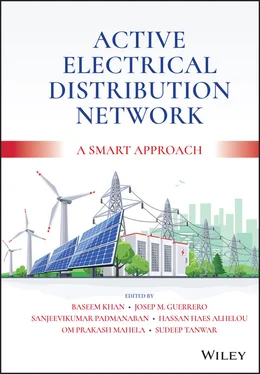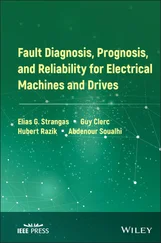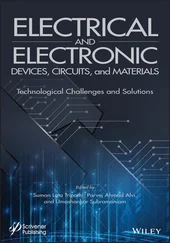Active Electrical Distribution Network
Здесь есть возможность читать онлайн «Active Electrical Distribution Network» — ознакомительный отрывок электронной книги совершенно бесплатно, а после прочтения отрывка купить полную версию. В некоторых случаях можно слушать аудио, скачать через торрент в формате fb2 и присутствует краткое содержание. Жанр: unrecognised, на английском языке. Описание произведения, (предисловие) а так же отзывы посетителей доступны на портале библиотеки ЛибКат.
- Название:Active Electrical Distribution Network
- Автор:
- Жанр:
- Год:неизвестен
- ISBN:нет данных
- Рейтинг книги:5 / 5. Голосов: 1
-
Избранное:Добавить в избранное
- Отзывы:
-
Ваша оценка:
- 100
- 1
- 2
- 3
- 4
- 5
Active Electrical Distribution Network: краткое содержание, описание и аннотация
Предлагаем к чтению аннотацию, описание, краткое содержание или предисловие (зависит от того, что написал сам автор книги «Active Electrical Distribution Network»). Если вы не нашли необходимую информацию о книге — напишите в комментариях, мы постараемся отыскать её.
Discover the major issues, solutions, techniques, and applications of active electrical distribution networks with this edited resource Active Electrical Distribution Network: A Smart Approach
Active Electrical Distribution Network: A Smart Approach
Active Electrical Distribution Network — читать онлайн ознакомительный отрывок
Ниже представлен текст книги, разбитый по страницам. Система сохранения места последней прочитанной страницы, позволяет с удобством читать онлайн бесплатно книгу «Active Electrical Distribution Network», без необходимости каждый раз заново искать на чём Вы остановились. Поставьте закладку, и сможете в любой момент перейти на страницу, на которой закончили чтение.
Интервал:
Закладка:
7 [ 7] T.M. Krishna, N.V. Ramana, and S. Kamakshaiah, “A novel algorithm for the loss estimation and minimization of radial distribution system with distributed generation,” 2013 International Conference on Energy Efficient Technologies for Sustainability, Nagercoil, 2013, pp. 1289–1293.
8 [ 8] S. Kalambe and G. Agnihotri, “Loss minimization techniques used in distribution network: Bibliographical survey,” Renewable and Sustainable Energy Reviews, vol. 29, pp. 184–200. 2014, R. Sangepu and V. Muni, Effect of power quality issues in power system and its mitigation by power electronics devices, Discovery, vol. 28, no. 105, pp. 72–79, 2015.
9 [ 9] R.M. Holmukhe, “Electricity distribution sector in India: Key challenges for service to customer & way out,” International Journal of Application or Innovation in Engineering & Management, vol. 5, no. 7, pp. 116–119, July 2016.
10 [ 10] E.M. García, A. Águila, I. Isaac, J.W. González, and G. López, “Analysis of voltage profile to determine energy demand using Monte Carlo algorithms and Markov Chains (MCMC),” Power Engineering Conference (UPEC) 2016, 51st International Universities, pp. 1–6, 2016.
11 [ 11] M.H. Salar and M.R. Haghifam, “Transmission loss allocation in power systems using artificial neural network,” 2010 IEEE International Conference on Power and Energy, Kuala Lumpur, 2010, pp. 729–734.
12 [ 12] S.S. Sarma, V. Madhusudhan, and V. Ganesh, “Evaluation and enhancement of reliability of electrical distribution system in the presence of dispersed generation,” 2016 International Conference on Signal Processing, Communication, Power and Embedded System (SCOPES), Paralakhemundi, 2016, pp. 357–362.
13 [ 13] P.K. Goswami, S. Chowdhury, S.P. Chowdhury, Y.H. Song, and J.K. Das, “Reliability evaluation of distribution system,” 2007 42nd International Universities Power Engineering Conference, Brighton, 2007, pp. 158–166.
14 [ 14] R. Billinton and J. Billinton, “Distribution system reliability indices,” IEEE Transactions on Power Delivery, vol. 4, no. 1, pp. 561–568, January 1989.
15 [ 15] A. Roy and S. Jain, “Contingency analysis in power system,” Thesis of Master of Engineering in Power Systems & Electric Drives, Thapar University, Patiala, 2011.
16 [ 16] R. Bacher, “Graphical interaction and visualization for the analysis and interpretation of contingency analysis results,” Proceedings of Power Industry Computer Applications Conference, Salt Lake City, UT, USA, 1995, pp. 128–134.
17 [ 17] V.J. Mishra and M.D. Khardenvis, “Contingency analysis of power system,” 2012 IEEE Students’ Conference on Electrical, Electronics and Computer Science, Bhopal, 2012, pp. 1–4.
18 [ 18] U.S. Department of Energy, Smart Grid, Available at: http://www.oe.energy.gov/smartgrid.htm. [Accessed 13 August 2020].
19 [ 19] B. Jiang and Y. Fei, “Dynamic residential demand response and distributed generation management in smart microgrid with hierarchical agents,” Energy Procedia, vol. 12, no. 2011, pp. 76–90, 2011.
20 [ 20] M. Singh, T.V. Vardhan, J. Pradhan, and K.S. Meera, “Reactive power management in transmission networks,” 2017 7th International Conference on Power Systems (ICPS), Pune, 2017, pp. 568–572.
21 [ 21] T.U. Okeke and R.G. Zaher, “Reactive power management for distributed generation: Motivation and solutions,” 2013 International Conference on New Concepts in Smart Cities: Fostering Public and Private Alliances (SmartMILE), Gijon, 2013, pp. 1–4
22 [ 22] H.W. Hong, C.T. Sun, V.M. Mesa, and S. Ng, “Protective device coordination expert system,” IEEE Transaction on Power Delivery, vol. 6, no. 1, pp. 359–365, 1991.
23 [ 23] S. Ruiz-Romero, A. Colmenar-Santos, R. Gil-Ortego, and A. Molina-Bonilla, “Distributed generation: The definitive boost for renewable energy in Spain,” Renewable Energy, vol. 53, no. 2013, pp. 354–364, 2013.
24 [ 24] M. Bajaj and A. Singh, “Grid integrated renewable DG systems: A review of power quality challenges and state‐of‐the‐art mitigation techniques,” International Journal of Energy Research, vol. 44, pp. 26–69, 2019.
25 [ 25] P. Kundur, Power System Stability and Control. New York: McGraw-Hill, 1994.
26 [ 26] N.K. Roy A, H.R. Pota, and M.J. Hossain, “Reactive power management of distribution networks with wind generation for improving voltage stability,” Renewable Energy, vol. 58, pp. 85–94, 2013.
27 [ 27] J.B. Ward, J.R. Eaton, and H.W. Hale, “Losses in power transmission networks,” Electrical Engineering, vol. 69, no. 5, pp. 451–451, May 1950.
28 [ 28] S. Ruifeng, Z. Penghui, Z. Jie, L. Niu, and H. Xiaoting, “Multidispatch for microgrid including renewable energy and electric vehicles with robust optimization algorithm,” Energies, vol. 13, no. 2813, pp. 1–15, 2020.
4 Power Quality Mitigation in a Distribution Network Using a Battery Energy Storage System
Gajendra Singh Chawda1, Om Prakash Mahela2, and Bhuvnesh Rathore3
1 Department of Electrical Engineering, Indian Institute of Technology, Jodhpur, Rajasthan, India
2 Power System Planning Division, Rajya Vidyut Prasaran Nigam Ltd., Jaipur, Rajasthan, India
3 Department of Electrical Engineering, MBM, Jodhpur, Rajasthan, India
4.1 Introduction
With increased industrialization and power demand, power engineers are looking for new and efficient ways for power generation and their sources. For this, renewable energy (RE) technologies are the best and most promising option/answer, along with an advantage of reduced carbon emissions [1]. Battery energy storage systems (BESSs) have been proved to be an efficient emerging technology for short-term power storage for power utilization for mitigation of various power quality (PQ) disturbances, stability, reliability, and protection [2–5].
In the current scenario, the demand for good quality of power in the distribution grid enhances significantly due to frequent use of smart equipment. These types of equipment are the primary cause of harmonics. This distribution equipment draws distorted sinusoidal current and behaves as nonlinear loads, which deteriorates the quality of supply in the network of the distribution grid [6]. Thus, PQ is defined by any deviation in frequency, voltage quality, and current quality of the electrical signal [7]. The major PQ issues include a low power factor, unbalanced voltage, reactive power requirement, and harmonics level in three-wire distribution systems. These issues generally originate due to the proliferation of nonlinear loads. It causes mal operation, failure, or damages of smart electrical equipment of the distribution network [8]. Hence, the nature of the distribution load at the point of common coupling (PCC) is of significant concern when analyzing the impact of the utility network performance given PQ in compliance of the IEEE 519-2014 standard [9].
Literature details the various smart solutions for the aforementioned problems in the distribution system. For this purpose, research on different design architectures of BESS for power quality application is under development [10]. The battery integrated with FACTS devices is one of the smart solutions for the distribution network [11, 12]. Also, there can be various topologies of the converters like a four-quadrant converter topology with which bidirectional energy flow can be achieved. The voltage source converter (VSC) has been used for modulating the energy flow in mostly BESS controllers for controlling active and reactive power simultaneously and independently [13]. An adequate charge controller is needed for appropriate charging of the battery, for when a battery is fully charged (constant voltage), its charge acceptance capability and charging current are both reduced [14, 15]. Thus, it takes a long time for full charging at a constant voltage. Hence, various control algorithms have been proposed in the literature, such as an instantaneous current control theory for PQ conditioning with BESS [16], a synchronous reference frame control theory for PQ mitigation in the presence of motor load [17], an adaptive linear element-based control for PQ improvement in the presence of multifarious loads [18], a least mean control algorithm for PQ mitigation in a weak grid environment with inductive nature loads [19], and application of a control algorithm for RE power generation [20,21] for power quality mitigation and maximum power extraction. Moreover, the performance comparisons of these algorithms have been presented in [22] for the power quality application.
Читать дальшеИнтервал:
Закладка:
Похожие книги на «Active Electrical Distribution Network»
Представляем Вашему вниманию похожие книги на «Active Electrical Distribution Network» списком для выбора. Мы отобрали схожую по названию и смыслу литературу в надежде предоставить читателям больше вариантов отыскать новые, интересные, ещё непрочитанные произведения.
Обсуждение, отзывы о книге «Active Electrical Distribution Network» и просто собственные мнения читателей. Оставьте ваши комментарии, напишите, что Вы думаете о произведении, его смысле или главных героях. Укажите что конкретно понравилось, а что нет, и почему Вы так считаете.











